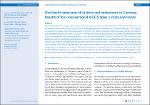Oral health behaviour of children and adolescents in Germany. Results of the cross-sectional KiGGS Wave 2 study and trends
Krause, Laura
Kuntz, Benjamin
Schenk, Liane
Knopf, Hildtraud
Oral health behaviour plays a key role in the prevention of caries and periodontitis. This article describes the
prevalence, determinants and trends of tooth brushing frequency and utilization of dental check-ups. The analyses
are based on the data from the second wave of the German Health Interview and Examination Survey for Children
and Adolescents (KiGGS Wave 2, 2014-2017). The results show that around 80% of children and adolescents meet
the recommended tooth brushing frequency and utilization of dental check-ups. Around one fifth of children and
adolescents do not meet the recommendations. 14- to 17-year-old adolescents, as well as those with low socioeconomic
status and a migration background are groups which are particularly at risk. Compared to the KiGGS baseline study
(2003-2006), tooth brushing frequency and utilization of dental check-ups has improved. While this positive
development is apparent for nearly all the population groups analysed, the same risk groups that were identified
by the baseline study are also evident in the KiGGS Wave 2 results. Targeted measures directed at specific target
groups to promote oral health behaviour at younger ages should therefore be maintained and expanded, respectively.
Files in this item
Notes
Die deutsche Version des Artikels ist verfügbar unter: http://doi.org/10.17886/RKI-GBE-2018-089

